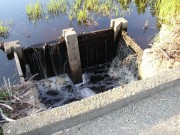The Moosehorn National Wildlife Refuge, a nature preserve, was established in 1937 as a refuge and breeding ground for migratory birds and other wildlife. It is the first in a chain of migratory bird refuges that extends from Maine to Florida. The refuge consists of two units. The Baring Unit covers 17,200 acres and is located off U.S. Route 1 north of Calais. The 7,200 acre Edmunds Unit borders the tidal waters of Cobscook Bay near Dennysville and is adjacent to Cobscook Bay State Park.
The refuge, operated by the U.S. Fish and Wildlife Service of the Department of the Interior, is a highly glaciated expanse of rolling hills, large ledge outcrops, streams, lakes, bogs, and marshes. A diverse forest of aspen, maple, birch, spruce, and fir dominates the landscape and scattered stands of majestic white pine are common. The Edmunds Unit boasts several miles of rocky shoreline where up to 24-foot tidal fluctuations occur twice a day. The video below was taken at the Edmunds Unit in 2004.
The area is rich with the history of the logging boom days. In the 1800’s horses hauled millions of cords of wood to the shores of the St. Croix River where Spring floods carried the logs to Calais mills. From Calais these products were shipped to world markets by schooner and steamship. However, as the 19th century dawned the forest industry began to mechanize and the world market for timber declined. The numerous farms that once were necessary to feed man and beast were abandoned and (almost unnoticed) the forest gradually reclaimed what was hers. A walk through refuge woodlands will reveal old cellar holes and rock fences.
In 1970 approximately 2,780 acres of the Edmunds Unit and, in 1975, 4,680 acres of the Baring Unit were set aside as Wilderness Areas by Congress. As part of the National Wilderness Preservation System these areas are granted special protection that will assure the preservation of their wilderness characteristics.
Wildlife
Moosehorn Refuge is unique among the country’s approximately 500 national wildlife refuges. Here the American Woodcock is intensely studied and managed. This reclusive shorebird dwells in the alder covers by day and refuge clearings at night. However, the woodcock is best known for its spectacular spring courtship flights. At twilight the male flies to a clearing and utters a series of nasal “peents”. He then takes wing in a spiral flight that takes him several hundred feet into the air while he warbles a plaintive song to waiting females. He returns to the same location several times over the next half hour. Unfortunately, this spring ritual is in danger; the Eastern Flyway woodcock population has declined steadily over the past two decades. Research and management programs at Moosehorn have provided valuable information which is being used to stem this decline.
The threatened Bald Eagle frequents both units of the refuge. In recent years as many as three pairs of eagles have nested at Moosehorn. Eagles are frequently sighted in the area around the Magurrewock Marshes near Rte.1 on the Baring Unit and around the tidal waters of Dennys Bay on the Edmunds Unit.
The woodlands of Moosehorn also abound with many other species. Black bears are abundant and can often be seen along refuge roads in the Spring, in the blueberry fields in August, and foraging for apples in the Fall. White-tailed deer and moose feed in the many clearings scattered throughout the refuge. In mid-May a flush of migrating warblers fills the woodlands with song.
The refuge also serves as an important breeding area and migration stop for a variety of waterfowl and other water birds, including ducks. Black Ducks, Wood Ducks, Ring-necked Ducks, Canada Geese and Loons can be seen on the 50 lakes, marshes, and flowages scattered throughout the refuge. In mid-May the Magurrewock Marsh, which borders U.S. Rt. 1 on the Baring Unit, abounds with goose and duck broods and Bald Eagle sightings are a common occurrence. Ospreys nest in several of the refuge marshes with many nesting on platforms along the Charlotte Road. The ardent observer can often find river otters frolicking among the cattails. Moosehorn plays an important role in protecting the fragile and diminishing wetland resources of the Atlantic Flyway.
Visitor Opportunities
Moosehorn offers its visitors over 50 miles of roads and trails which are closed to vehicle traffic but open for hiking, cross country skiing, and snowmobiling. Many refuge streams and lakes are open to fishing and boat access is provided at Bease Lake (no motors) and Vose Pond. The refuge is also open to deer hunting in November. Refuge visitors are invited to accompany wildlife biologists on waterfowl and woodcock banding operations (check ahead for schedules).
More Videos!
Additional resources
Refuge Manager, Moosehorn National Wildlife Refuge. RR1 Box 202 Suite 1, Baring, Maine 04694-9703. Phone: 207-454-7161.
Devine, Michael E. Resurvey of Spruce Budworm Damage in the Moosehorn National Wildlife Refuge. Augusta, Me. Maine Forest Service. 1981. [University of Maine, Raymond H. Fogler Library, Special Collections; Maine State Library]
Hearing impaired visitors may call the Maine Relay Center at 1-800-437-1220 TDD /1-800-457-1220 voice.
Montag, Jessica M. Moosehorn National Wildlife Refuge Workbook Summary [electronic resource]. Reston, Va. U.S. Geological Survey. 2009. [University of Maine, Raymond H. Fogler Library, Government Documents; University of Southern Maine, Government Documents.]
Moosehorn National Wildlife Refuge. Washington, D.C. U.S. Fish & Wildlife Service. 2000. http://library.fws.gov/Refuges/moosehorn00.pdf (accessed January 26, 2012)
Moosehorn National Wildlife Refuge: Birds. Washington, D.C. U.S. Fish & Wildlife Service. 2009. [University of Maine, Raymond H. Fogler Library, Government Documents; Bangor Public Library, Government Documents.]
Moosehorn Web site: http://moosehorn.fws.gov/
Rudbeck, James P. An Economic Evaluation of a Recreational Area in Washington County – Moosehorn National Wildlife Refuge. 1965. ( Thesis (M.S.) in Agricultural Business and Economics–University of Maine, 1965.) [University of Maine, Raymond H. Fogler Library, Special Collections]




